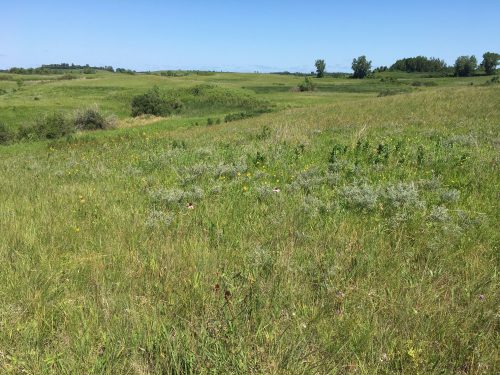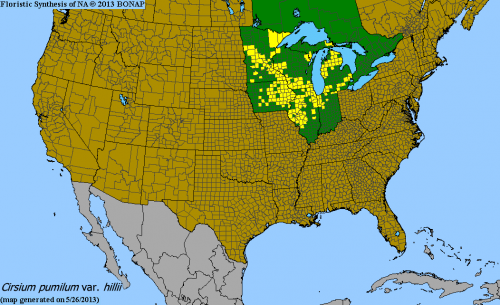|
|
Wes Braker, an REU student in summer 2017, characterized the vegetation in remnant prairie, restored prairie, and old agricultural fields at Hegg Lake State Wildlife Management Area. Prairie communities with a large variety of native plant species are considered generally healthy communities. Wes wanted to characterize the plant communities at these sites and provide information to land managers.
Each area at Hegg Lake WMA was classified as remnant prairie, restored prairie, or abandoned agricultural field. Using Google Earth, areas were mapped out and labeled and three areas were chosen based on their availability for sampling, for a total of 27 study areas. Wes sampled vegetation each week for a total of 8 weeks across the growing season.
 A snapshot of the landscape at Hegg Lake State Wildlife Management Area. The purpose of this project was to characterize the vegetation at this site, building a species list for use by the Minnesota Department of Natural Resources for potential use in local seed sourcing for future restorations. From this project, Wes identified 25 native prairie species for use in future Hegg Lake seed collections. In addition, he identified 80 unique plant species at this site.
This summer we collected samples of pollinators from 39 roadside sites using yellow pan traps. We captured over 400 insects across 8 weeks. The specimens are stored frozen until pinning and identification. We will use this information to make comparisons between the pollinator communities collected in 2004. This information could inform potential diversity and abundance changes across the 13 years, and provide valuable insight into potential pollinator decline in this system.
Pollinator diversity and abundance are declining due in part to land use changes such as habitat destruction & fragmentation, pesticide contamination, and numerous other anthropogenic disturbances. The extent to which pollinator diversity and abundance is changing is not well understood, especially within tallgrass prairie ecosystems. Pollinators are important in the prairie: they provide valuable ecosystem services to native plants and to important plants used in agriculture.
The goal of this experiment was to repeat a similar study done in 2004 by Wagenius and Lyon, in which they collected information on pollinator abundance and diversity with the aim of relating landscape characteristics to bee community composition.
 Augochlorella sp. foraging for pollen. Our yellow pan traps are similar in color.
This year we monitored the original 28 C. hillii rosettes at Hegg Lake WMA to check the fitness and persistence of our original individuals/population. Presently, 10/28 rosettes remain, all as non-flowering basal rosettes. For each rosette, we measured the length of the longest axis and the corresponding perpendicular axis. No burns were conducted this year.
This experiment assesses effects of fire on the fitness of Cirsium hillii (Hill’s thistle) plants at Hegg Lake WMA. Like Echinacea, C. hillii inhabits dry prairies, but Hill’s thistle is listed as a Species of Special Concern in Minnesota and little is known about how it responds to fire. Burn and non-burn units were created prior to an experimental fall burn conducted by the Department of Natural Resources (DNR) in 2014. That year, we mapped 28 C. hillii rosettes (basal and flowering).
 The distribution of Cirsium hillii, a rare endemic to the Great Lakes region. Last year was also a non-burn year, although of rosettes found, there were three flowering rosettes. It’s challenging to determine cases of mortality with this species, since C. hillii is clonal, and it’s possible that each rosette is not a unique individual.
In 2015, Abbey White found that there was only one or two individuals in our C. hillii “population!” We don’t know of any other C. hillii populations in Douglas County. We are possibly monitoring the last individual in the area.
You can find out more about Cirsium hillii fire & fitness and read previous flog posts about it on the experiment background page.
Today was another chilly day at the Echinacea Project with highs reaching up into the low 60ºs. Tracie and I spent the morning working on harvesting Lea’s Aster Phenology at SPP. Many of the Liatris are finished flowering and ready for harvest, but some of the Solidago plants still have at least another month or two before they will be ready.
 Prenanthes racemosa In the afternoon we spent our time out at Stephen’s Approach working on more seedling refinds. Between Tracie and I, and later also Stuart and Alex it took us about 3 hours to complete 13 focal plants. This is one of the more challenging activities that we do at the Echinacea Project, however, the glory of finding one of last year’s plastic swords or toothpicks is immeasurable.
 Actual seedling refinds map found today. Luckily another map was found for the same site with the correct seedling locations.
Today was another relaxed Saturday. Each of us at Andes had a number of errands to run including the very important task of getting the doggies groomed and cleaned before heading back to Evanston! Lea took the doggies in to Bark n Bubble in town for an all over spa treatment.

Later in the evening Lea, Tracie, and I celebrated Lea’s last day by enjoying some wine and having a ladies night in.
Today was pretty relaxed here at Andes. Wes is gone for the weekend on a camping trip with his family and by mid-morning most of the team was out in Alex running errands. Lea spent some time with her plots at Staffanson but unfortunately the humidity meant the mosquitoes were out as well.
This evening, Lea and Tracie graciously took me to try Copper Trail Brewing Co. If anyone needs a good recommendation for craft brew in the greater Alex metro area, I would highly recommend it.

After checking our IDs, we were first mistaken for members of the notoriously famous “Bee Crew” (Amy’s team) although we quickly explained that we are actually part of the just as fun and exciting “Plant Crew.”
This was a great first week, and great introduction to all the work going on this summer with Team Echinacea. Despite everyone else’s familiarity with the procedures, everyone has served as great mentors and teachers this week as I do my best to catch up.
Each day I spent a bit of time doing something different. Monday was spent looking at Lea’s project on Solidago and Liatris, some time on rechecks, and also demo! On Tuesday Stuart introduced me to Hegg lake and the number of interesting projects going on out at that location. I also pinned insects some this week with Alex (yay bees!) and did vegetation with Lea and Tracie.

I’ve set a few goals for myself this summer: these include becoming comfortable with naming the local vegetation and pollinators, developing my skills in R, and staying up on current literature. I’m really enjoying learning about everyone’s projects, developing my skills, and getting to know everyone better.
Today was mostly relaxed, but I decided to get out of the house for a bit this afternoon and check out Runestone County Park. The story goes that a group of Vikings were commissioned by the then current King of Norway to travel to the west. After traveling through the Arctic Ocean, this small group of Vikings ended up in the Hudson Bay and then trekked south into Minnesota. Near Kensington these Vikings were ambushed (likely by Native Americans) and left behind the “Runestone” or an inscription which detailed their encounter. A man and his son discovered the tablet in the late 1800s, prompting investigations into the first recorded history of Europeans in North America.
People remain skeptical of the Runestone, however, after numerous Wikipedia searches it seems that there is some evidence suggesting the story to be true. While we may never know which group of Europeans reached North America first, the park is pretty and serene, and serves as a unique part of an interesting local legend.
Echinacea Project 2017
B.S. Ecology & Evolutionary Biology, University of Kansas, 2017
Research Interests
Broadly speaking, my interests are in plant-pollinator conservation and restoration in native tallgrass prairie. I am interested in the interplay between landscape dynamics such as habitat fragmentation, and its effects on community composition, diversity, and success of both plants and pollinators. How can we utilize this information to help inform land management decisions, and continue to protect and conserve this natural resource?
Statement
I originally grew up all over the country, but eventually found my way back to the heartland through Kansas by way of Missouri. I have a number of interests in science other than plant biology including entomology, herpetology, and mycology. I am also very passionate about the human impact of science on the public, and enjoy participating in scientific outreach and science diversity educational programming. In my free time I like to travel, study Spanish, drink tea, and enjoy a good book. I am looking forward to joining the Master’s Program in Plant Biology & Conservation this fall at Northwestern.

|
|









